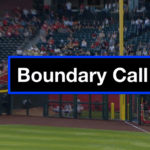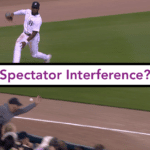SPECTATOR INTERFERENCE
Rules 6.01(e), 6.01(e) Comment:
The umpire shall call spectator interference by first signaling and calling “Time” (both hands overhead) to halt play and then grasping the left wrist with right hand (held above the head) to indicate spectator interference. When there is intentional interference with a ball in play, either by a spectator or by a person permitted on the playing field (as covered in Official Baseball Rule 6.01(d)), the ball is dead the instant the interference occurs. The umpire who calls the interference (any umpire may call it) should consult with other umpires to determine what reasonably might have happened had the interference not occurred.
The spectator interference rule states specifically that the umpire shall impose such penalty or penalties as in the umpire’s judgment will nullify the act of interference, and the ball is dead the instant the interference occurs.
For the purposes of Official Baseball Rule 6.01(e): If a spectator touches the ball while beyond the front of a padded wall (regardless of whether the padding reaches the top of the concrete fence; i.e., onto the field of play), such act shall constitute spectator interference. The ball becomes dead at the moment of the interference and the umpire shall impose such penalties as in his opinion will nullify the act of interference.
A padded wall attached to a concrete fence shall be considered part of the fence; provided that the padding is designed to reach the top of the fence. (However, if such padding does not reach the top of the fence, and instead the top of the fence is higher and recessed back from the top of the padding attached to it, then the padding shall be considered “part of the playing field”). If a batted, thrown or pitched ball should land on top of the padded wall it is alive and in play. If a player can reach the ball on top of the padded wall it stays alive and in play. If a player cannot reach the ball, then it is considered “out of play.” Fair fly balls striking the top of the outfield wall shall continue to be governed by rule interpretation #9 in this Umpire Manual.
Note that on non-home run boundary areas, any batted, thrown or pitched ball that hits, rolls or stops on the top of the wall or fence (including the padding attached along the stands) is alive and in play. If, however, such batted, thrown or pitched ball has not yet entered into the stands and is touched by a spectator, it shall be deemed “out of play” and not “spectator interference.” All of these situations are subject to replay review per the Replay Regulations.
It is possible to have spectator interference on a ball pitched to the batter. If a wild pitch does not go into the stands but remains in play and is interfered with by a spectator, the spectator interference penalty shall apply. The very nature of the game requires different consideration of what may at first seem the same play (dimensions of the ball park, speed of runner, etc.). The umpires should consider all factors in determining penalties for spectator interference. Refer also to Official Baseball Rule 6.01(e).







